Exam AZ-301: Microsoft Azure Architect Design

Microsoft AZ-301 just like any other Azure role-based exams follows a similar structure. And, since this examination is in association with AZ-300, you must already have prior experience about exam policies, pattern, scoring, and related aspects. However, one must be thorough with each and every exam detail as each exam has different objectives. Moreover, it will help you solidify your knowledge in Azure exams. So, let’s begin with the overview of the AZ-301 exam.
Microsoft AZ-301 exam is retired. A new replacement exam Microsoft Azure Architect Design (AZ-304) is available.

Intended Audience
Candidates for this examination are Azure Solution Architects who guide stakeholders and translate business requirements into safe, scalable, and reliable solutions.
Recommended Knowledge
Candidates must have exceptional knowledge and expertise across various aspects of IT operations. These include-
- Networking
- Virtualization
- Identity
- Security
- Business continuity
- Disaster recovery
- Data management
- Budgeting
- Governance
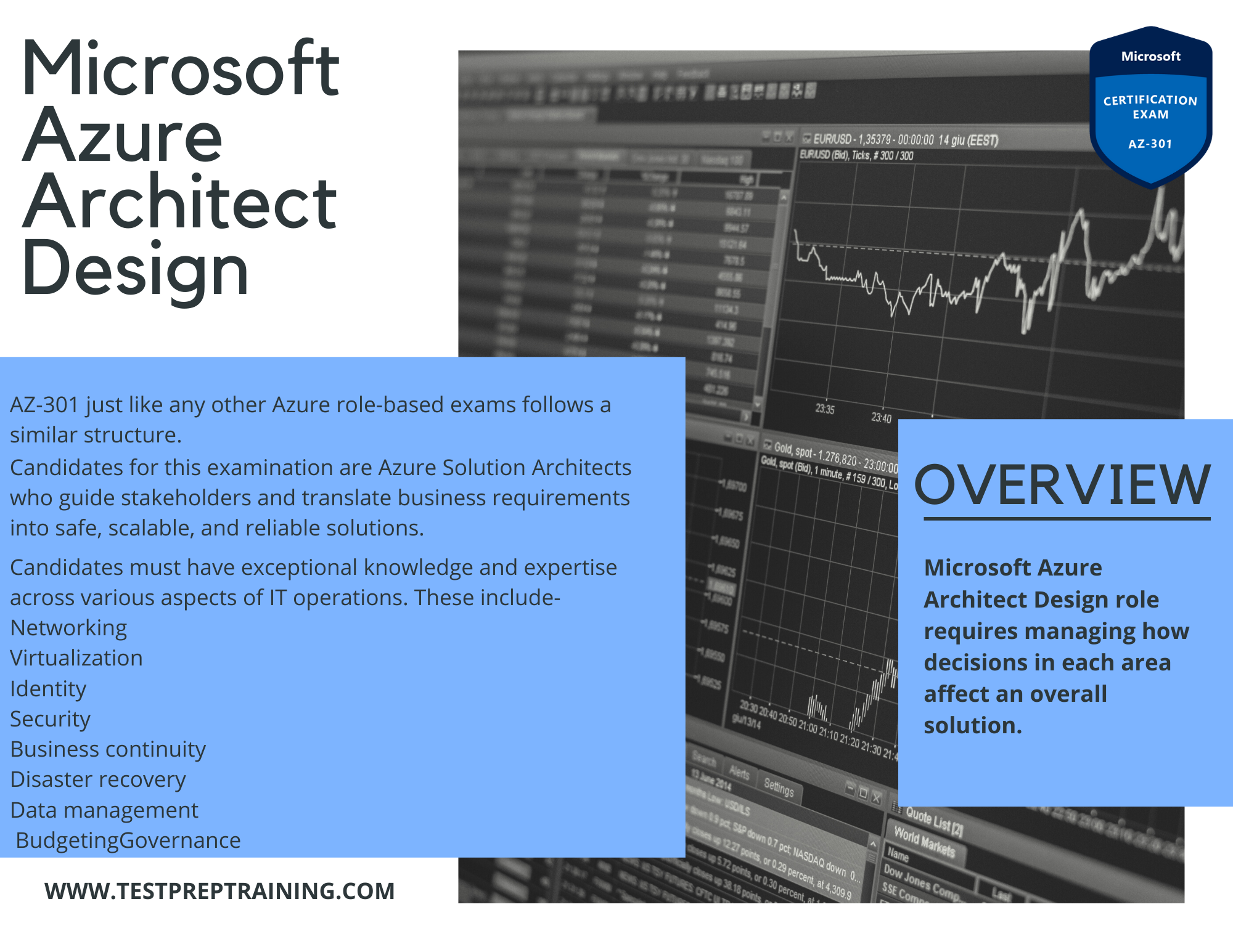
Microsoft Azure Architect Design role requires managing how decisions in each area affect an overall solution. So, candidates must be proficient in Azure administration, Azure development, and DevOps, and have expert-level skills in at least one of those domains.
Basic Exam Details: AZ-301 exam
The Microsoft AZ-301 exam is 150 minutes long. Though the examination comprises 40-60 questions as the number of questions keep on changing over time. Speaking of which, the candidate may encounter Multiple Choice and Multi-Response Questions. However, there are no prerequisites. And, as far as the language of the exam is concerned. The exam is only available in only 4 languages. Further, these include English, Japanese, Chinese (Simplified), Korean.
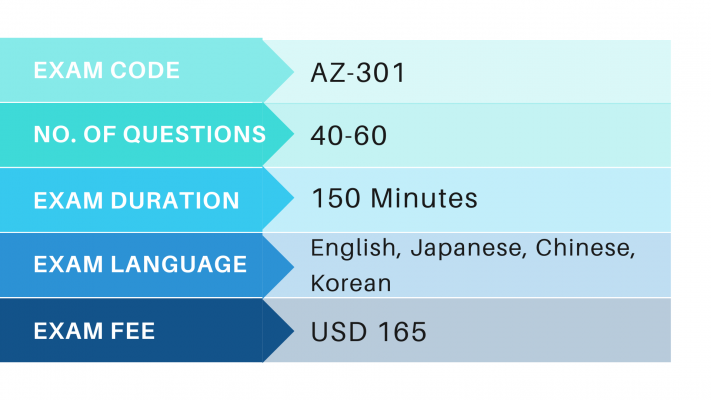
Exam Pricing
The registration fee for the AZ-301 exam is USD 165 (without taxes). Since the pricing doesn’t include the applicable taxes, hence one must confirm with their exam provider beforehand. Though pricing may vary from country to country.
And, in case, you are a student, you’re qualified for a fee reduction. But only, if you submit your valid educational credentials. Also, if you’re a Microsoft Partner Network Program Members, then Microsoft trainers, and Academy program members are also qualified for reduced pricing.
Exam Results
Results have both a happy as well as a scare feel to it. However, results are the most important criteria of an examination. And, in the case of AZ-301, results will be declared within a few minutes after the end of the examination.In addition, the printed report card with each and every detail of your examination performance will be mailed to you within 5 business days.
This scorecard includes different details such as your pass/fail status, performance in different skill areas in the exam, overall performance.
How to Schedule the exam?
The Microsoft Azure Architects Design (AZ-301) exam has been built to measure your ability to understand the basic of cloud concepts, understanding core Azure services; security, privacy, compliance, and trust; as well as Azure pricing and support.
- For Non-Students interested in Technology

- For Students or Instructors

Now, that we have acquired all the information related to AZ-301 exam. It’s time for you to understand the Course Outline. The Course Outline forms the most crucial aspect of the examination. So, let’s begin.
Course Outline: AZ-301 exam
As mentioned earlier, the Course Outline is the most important part while preparing for the AZ-301 exam. Since this will allow you to have a clearer view of the course. Microsoft offers a list of domains which provides a brief overview of each and every topic in detail. For candidate’s convenience, Microsoft structures different modules in such a way that it is easy to adapt and structure preparation accordingly.
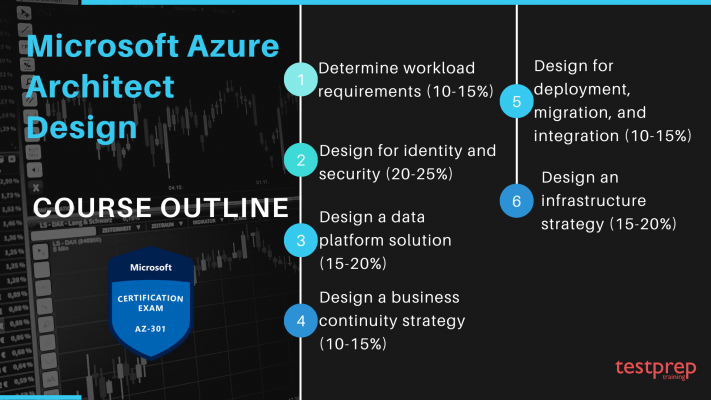
Domain 1: Determine workload requirements (10-15%)
- Gathering information and requirements
- identify compliance requirements
- identify identity and access management infrastructure
- identify service-oriented architectures
- identify accessibility requirements
- identify availability requirements
- identify capacity planning and scalability requirements
- identify deployability requirements
- identify configurability
- identify governance requirements
- identify maintainability requirements
- identify security requirements
- identify sizing requirements
- recommend changes during project execution
- evaluate products and services to align with the solution
- create testing scenarios
- Optimizing consumption strategy
- optimize app service costs
- optimize compute costs
- optimize identity costs
- optimize network costs
- optimize storage costs
- Designing an auditing and monitoring strategy
- define logical groupings (tags) for resources to be monitored
- determine levels and storage locations for logs
- plan for integration with monitoring tools
- recommend appropriate monitoring tool(s) for a solution
- specify the mechanism for event routing and escalation
- design auditing for compliance requirements
- design auditing policies and traceability requirements
Domain 2: Design for identity and security (20-25%)
- Designing identity management
- choose an identity management approach
- design an identity delegation strategy
- design an identity repository
- design self-service identity management
- design user and persona provisioning
- define personas
- define roles
- recommend appropriate access control strategy
- Designing authentication
- choose an authentication approach
- design a single-sign-on approach
- design for IPSec authentication
- design for login authentication
- design for multi-factor authentication
- design for network access authentication
- design for remote authentication
- Designing authorization
- choose an authorization approach
- define access permissions and privileges
- design secure delegated access
- recommend when and how to use API Keys
- Designing for risk prevention for identity
- design a risk assessment strategy
- evaluate agreements involving services or products from vendors and contractors
- update solution design to address and mitigate changes to existing security policies,
- standards, guidelines and procedures
- Designing a monitoring strategy for identity and security
- design for alert notifications
- design an alert and metrics strategy
- recommend authentication monitors
Domain 3: Design a data platform solution (15-20%)
- Designing a data management strategy
- choose between managed and unmanaged datastore
- choose between relational and non-relational databases
- design a data auditing strategy
- design a data caching strategy
- identify data attributes
- recommend database service tier sizing
- design a data retention policy
- design for data availability
- design for data consistency
- design for data durability
- design a data warehouse strategy
- Designing a data protection strategy
- recommend geographic data storage
- design an encryption strategy for data at rest
- design an encryption strategy for data in transmission
- design an encryption strategy for data in use
- design a scalability strategy for data
- design secure access to data
- design a data loss prevention (DLP) policy
- Designing and documenting data flows
- identify data flow requirements
- create a data flow diagram
- design a data flow to meet business requirements
- design data flow solutions
- design a data import and export strategy
- Designing a monitoring strategy for the data platform
- design for alert notifications
- design an alert and metrics strategy
- monitor Azure Data Factory pipelines
Domain 4: Design a business continuity strategy (10-15%)
- Designing a site recovery strategy
- design a recovery solution
- design a site recovery replication policy
- design for site recovery capacity
- design for storage replication
- design site failover and failback
- design the site recovery network
- recommend recovery objectives (Azure, on-prem, hybrid, Recovery Time Objective (RTO), Recovery Level Objective (RLO), Recovery Point Objective (RPO))
- identify resources that require site recovery
- identify supported and unsupported workloads
- recommend a geographical distribution strategy
- Designing for high availability
- design for application redundancy
- design for autoscaling
- design for data centre and fault domain redundancy
- design for network redundancy
- identify resources that require high availability
- identify storage types for high availability
- design a disaster recovery strategy for individual workloads
- design failover/failback scenarios
- document recovery requirements
- identify resources that require backup
- recommend a geographic availability strategy
- Designing a data archiving strategy
- recommend storage types and methodology for data archiving
- identify business compliance requirements for data archiving
- identify requirements for data archiving
- identify SLA(s) for data archiving
Domain 5: Design for deployment, migration, and integration (10-15%)
- Designing deployments
- design a compute deployment strategy
- design a container deployment strategy
- design a data platform deployment strategy
- design a messaging solution deployment strategy
- design a storage deployment strategy
- design a web app and service deployment strategy
- Designing migrations
- recommend a migration strategy
- design data import/export strategies during migration
- determine the appropriate application migration method
- determine the appropriate data transfer method
- determine the appropriate network connectivity method
- determine migration scope, including redundant, related, trivial, and outdated data
- determine application and data compatibility
- Designing an API integration strategy
- design an API gateway strategy
- determine policies for internal and external consumption of APIs
- recommend a hosting structure for API management
Domain 6: Design an infrastructure strategy (15-20%)
- Designing a storage strategy
- design a storage provisioning strategy
- design storage access strategy
- identify storage requirements
- recommend a storage solution
- recommend storage management tools
- Designing a computing strategy
- design a compute provisioning strategy
- design a secure compute strategy
- determine appropriate compute technologies
- design an Azure HPC environment
- identify compute requirements
- recommend management tools for computing
- Designing a networking strategy
- design a network provisioning strategy
- design a network security strategy
- determine appropriate network connectivity technologies
- identify networking requirements
- recommend network management tools
- recommend network security solutions
- Designing a monitoring strategy for infrastructure
- design for alert notifications
- design an alert and metrics strategy
And, this marks the end of the Course Outline. Though a little lengthy to cope up. But, not to fret! Further, we’re providing such learning resources and learning strategy that’ll be beneficial to each one of you.
Exam Policies
While preparing for Microsoft Azure Architect Design (AZ-301) exam you will be solely responsible for understanding and complying with Microsoft Certification exam policies, together with the specified exam delivery provider’s policies and procedures.
Also, you can go through the Exam Retake Policy together with other Microsoft exam available and exam testing procedures. The exam policy page provides details of the exam provider’s policies and procedures together with the exam provider’s details. Note, you will have 30 days after taking an exam to challenge your exam score for that exam.
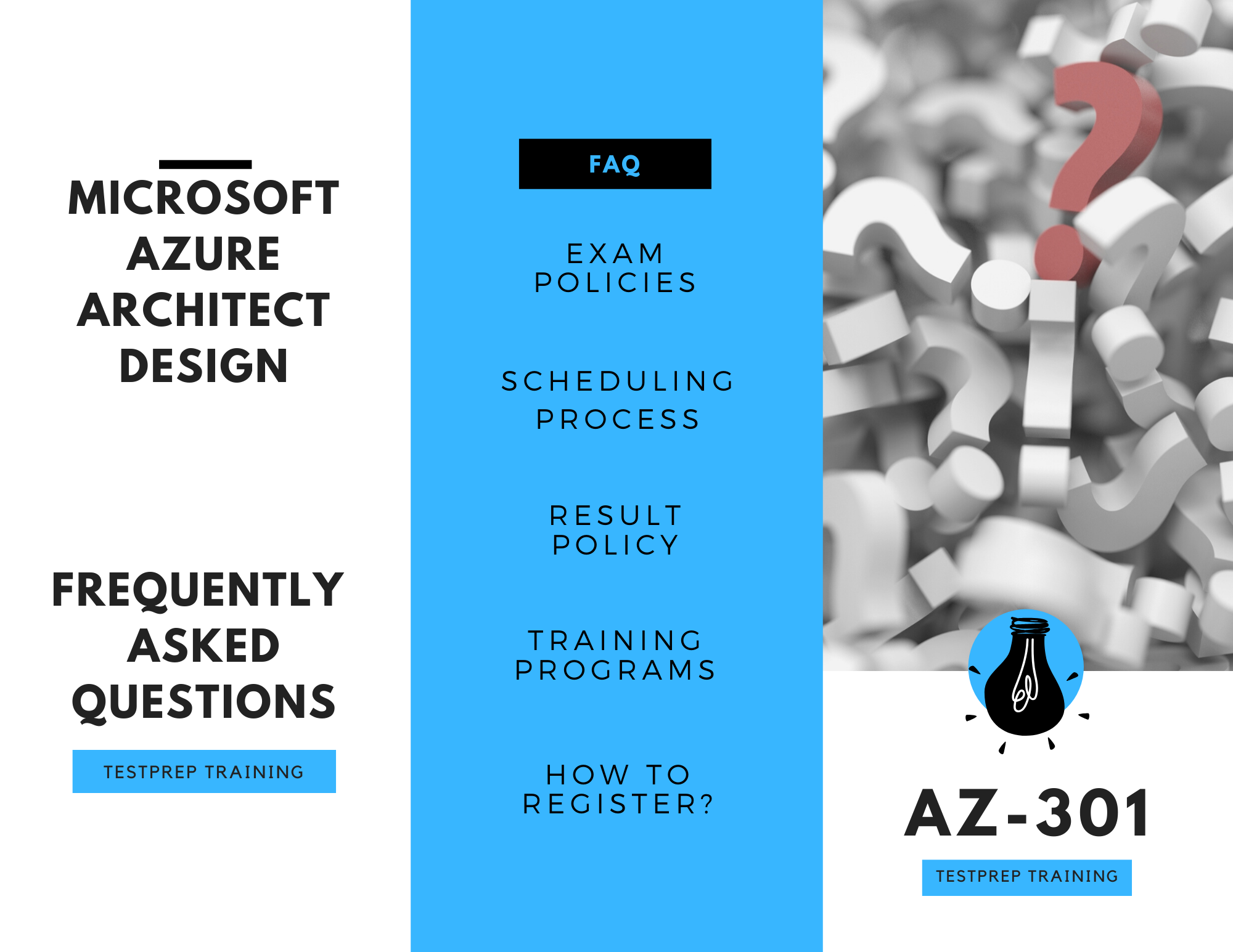
For more queries, visit the Microsoft AZ-301 exam FAQ
Master Study Guide for AZ-301
Certification exam may seem scary but with right learning resources, one can qualify the AZ-301 exam in the very first attempt. But, before we begin with the preparatory guide, one must keep in mind that there is no single strategy for all. Something that works for you, may not work for the other and vice versa. However, there’s something called the systematic approach. Therefore, in this section, we’re going to provide a ladder you must walkthrough in the same order as mentioned below.
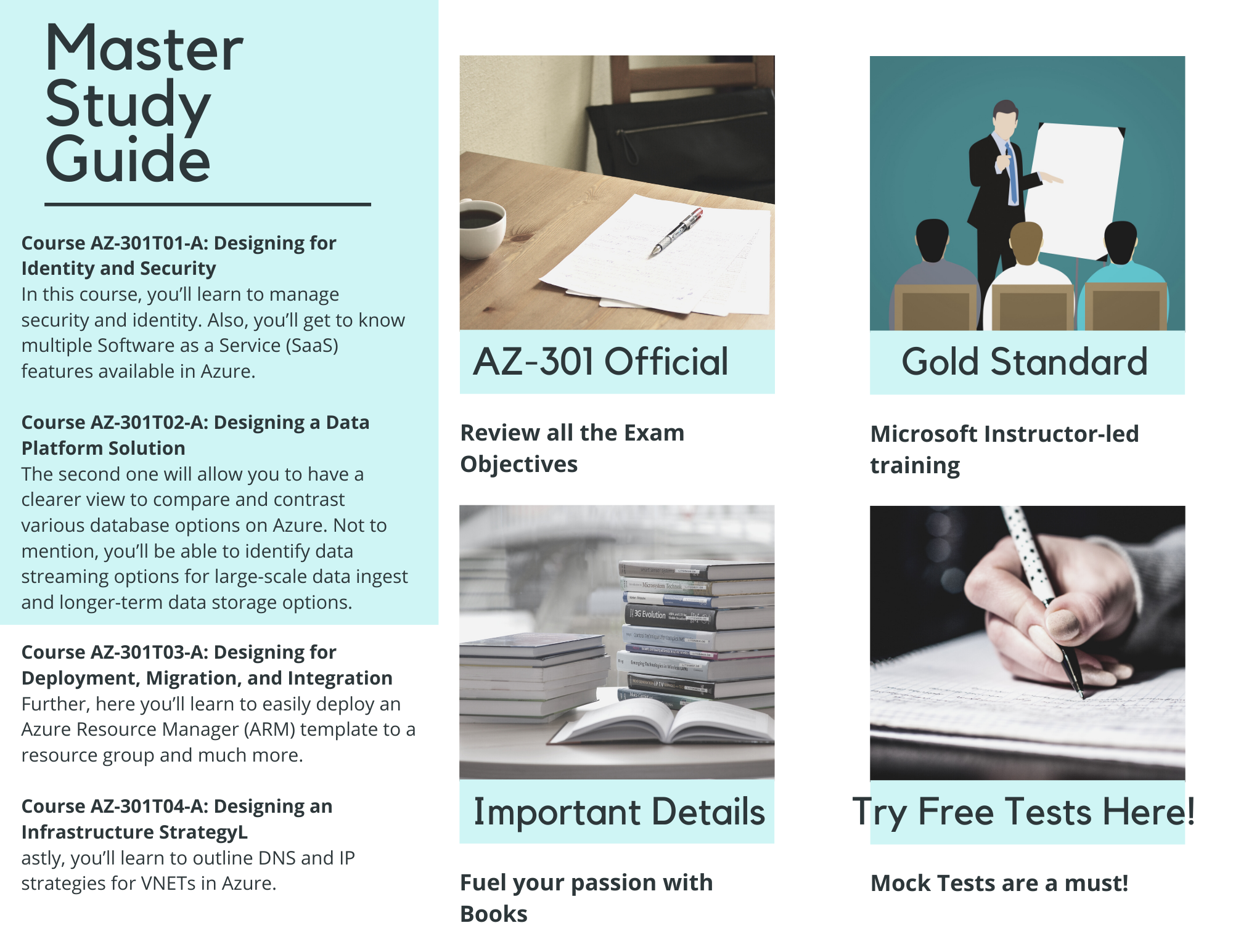
Review all the Exam Objectives
Your first step in the preparation guide is to review all the exam objectives. And, to do so, make sure to visit the Official Website of Microsoft AZ-301 exam. As this is the most authentic site for obvious reasons. By doing so, you’ll have a clear view of each and every information related to the AZ-301 exam. So, make sure, to begin with, this step.
Download Exam skill Outline
After this, you must download the exam skill outline available on the official website itself. Downloading the outline will provide you with the updated exam outline. All the domains and their subtopics are listed down in the outline. Keep in mind not to rely on any other website except the official website itself. Since the exam is updated after every few years hence the official website is your door to reliable information.
Microsoft Instructor-led training: the Gold standard of learning
Next up, we have Instructor-led training. Instructor-led training is paid online classes offered by Microsoft itself. For AZ-301 exam, Microsoft has formulated 4 different courses. These are as follows-
Course AZ-301T01-A: Designing for Identity and Security
In this course, you’ll learn to manage security and identity. Also, you’ll get to know multiple Software as a Service (SaaS) features available in Azure.
Course AZ-301T02-A: Designing a Data Platform Solution
The second one will allow you to have a clearer view to compare and contrast various database options on Azure. Not to mention, you’ll be able to identify data streaming options for large-scale data ingest and longer-term data storage options.
Course AZ-301T03-A: Designing for Deployment, Migration, and Integration
Further, here you’ll learn to easily deploy an Azure Resource Manager (ARM) template to a resource group and much more.
Course AZ-301T04-A: Designing an Infrastructure Strategy
Lastly, you’ll learn to outline DNS and IP strategies for VNETs in Azure.
All the above-mentioned courses will eliminate the fear of studying old and outdated resources. Moreover, it will help you interact with the experts. Thereby, a gold standard of learning.
Fuel your passion with Books
Books have always been a part of human life. From the very beginning, books have been an integral part of human life. Not to mention, these provide you with great learning without any distractions. So, make sure to go through books as a traditional way of learning isn’ that boring. Here is a list of books that we highly suggest-
- Exam AZ-300 & AZ-301 Study & Lab Guide Part 1and Part 2: Microsoft Certified Azure Solutions Architect Expert by Harinder Kohli.
- Microsoft AZ-301 Exam Preparation by Georgio Daccache.
- Azure Solutions Architect Study Guide by Benjamin Perkins.
Join a Community
Online forums and study groups are a great way to prepare for the AZ-301 exam. Therefore, feel free to get in touch with other candidates through study forums or online groups to ask question-related to the topic you’re having difficulty with.
However, it’s not something you have to join. It’s just something very subjective. Not to mention, these online groups help you stay equated with the other people who are also walking through the same path as yours. Moreover, you can also ask a question related to the topic you’re having difficulty with.
Mock Tests are a must!
And, finally, it’s time for practice sessions. Take it from us, Self Evaluation is the only step you need in the end. The more you’re going to practice, it’s better for you. Since there are many hidden rocks in any exam and you’ll only be able to confront them with the help of practice sets. So, go through as many practice tests as much you can. FOR MORE PRACTICE TEST, CLICK HERE!
After going through the learning resources, you’ll realise that learning resources play a huge factor in the preparation. But, the way you study and how much hours you dedicate also are essentials factors to contribute.
Elevate your career and prepare for the Microsoft AZ-301 exam. Become a Microsoft Certified: Azure Solutions Architect Expert

